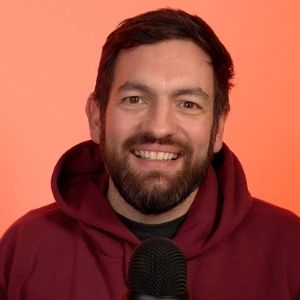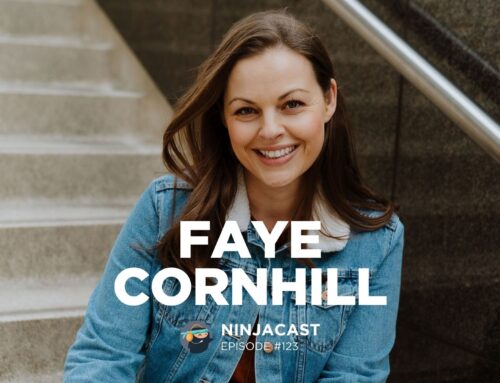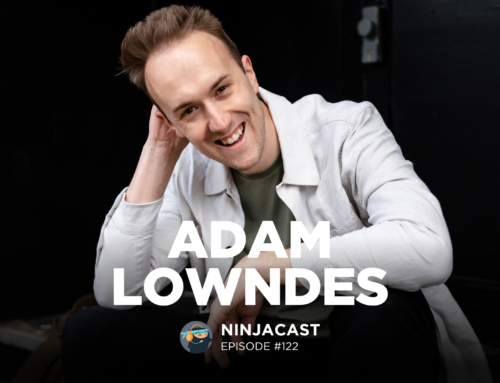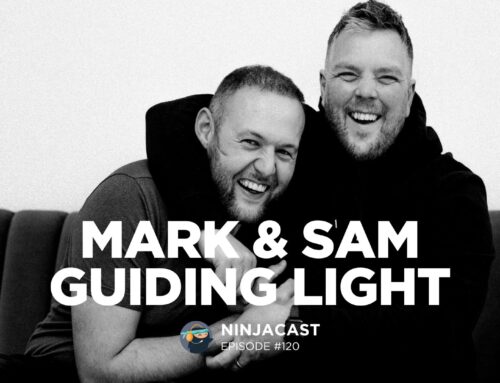021: Neil Redfern – How To Use Artificial Light To Take Your Images Up A Level & The Importance Experimenting
February 20, 2021
“Show the work that you want to be booked for. Less is more!”
NEIL REDFERN
Hey everyone! It’s Sally here, from Studio Ninja. Today’s episode is all about Neil Redfern – we are really excited to have him on the show.
Check out some of the biggest points from Neil’s interview below:
What techniques do you find that you use to elevate your work?
Yeah, it’s a good question. Before I answer that, it almost goes back to what we were saying about the business and marketing, because if anybody looks at my work, if someone wants to look at my Instagram, I think you probably think I spend three, four hours with a couple taking portraits on a wedding day, doing all these crazy things. Where I don’t at all. So, I would say, 90%, if not more of a wedding day, I shoot in a completely documentary way. I don’t involve myself with the couple, I don’t interact with them. I have silent cameras. I try to shoot the day as if it would happen as if I wasn’t even there. So, that is how I approach a wedding day.
So for me, if the average wedding day for me is 12 hours, say, 11 of those hours, I’m not in any way interacting with the couple. This is where maybe the marketing side comes into it a little bit more, it’s the portraits of the couple I take that I show. So I think that couples often book me because they’ve seen creative portraits on my Instagram or website. And then it’s my job, I feel, to educate them a little bit in the inquiry meeting before the wedding. So, I personally feel that documentary photographs have much more of a timeless quality to them and they’re going to increase in value over the years, whereas, the portraits will probably decrease really in terms of their importance.
I always like to think of my couples, hopefully, in 30, 40 years, looking back on their wedding pictures and it won’t be the epic, off-camera flash photograph that they’re going to say, “Oh, remember that?” It won’t happen. Whereas, the hug, the looks, that little fleeting moment, will be hopefully what stands the test of time. But I feel like you can’t really build a business very easily on documentary because if you’re in documentary these days, so is everybody else. So you’re in a pool with hundreds and hundreds of other photographers, local to you. Whereas, if you’re trying to concentrate on really creative, a little bit more different, unique portraits, that puts you in a much smaller pool. And it’s easier, I feel, to stand out with that.
So that’s the reason that a lot of people’s perception of my work is actually very different to what it is in reality. But that’s by design. That’s how I want to set the business up because those portraits, I feel, get me online attention. So it’s almost like a hook. And then once bride and grooms are interested, that’s when I’ll show them the rest of my work and I’ll show them all the documentary stuff. So, yeah. I always feel as if that’s important to say, because people’s perception would be very different than the reality.
And that’s the reason that I started going down that route of the more creative shots because I wanted to stand out more. And I do that through a combination of off-camera flash and shooting through various things, be it, crystals, fairy lights, prisms, different glass filters, basically anything I can get me hands on. And I’m always obsessed, it’s like a real interest of mine, to try out new things. Not really often on a wedding day, but I do a lot of shoots for me, which I’ll often film the behind the scenes of, and I use them for YouTube.
But I love experimenting. And I think it’s good to always be inquisitive and think, “What happens if I shoot through tin foil? What happens if I shoot through this pint glass?” All these things. “What will happen if I put this in front of the lens?” And then that feeds my curiosity. And when things sometimes hopefully work, that’s when I’ll take it into my wedding work.

So, going from being quite documentary all day, not really interacting a great deal with the couple, just so they can be in their moment, to then going in and giving a bit of direction and being quite specific about where you want them to stand or how you want them to be during those creative portraits. How does that work for you?
Yeah, it’s a very good question and posing is the thing that I think we as a collective of photographers probably struggle with sometimes, especially if you got a couple who feel a little bit awkward. It almost starts at the first inquiry that you get. And what I mean by that is, that’s the time that I try and project, hopefully, I like to think I’m quite a easy-going, relaxed person, and people can hopefully feel that from when we first start talking and that’s important. Because it’s imperative, it’s absolutely vital that your bride and groom feel really comfortable in front of your lens. Otherwise, it’s almost going to be impossible to pose them.
So, it starts off from the first inquiry, where I’ll be like, even my reply email’s, smiley, exclamation marks, being really friendly when we speak on the, well, I was going to say speak in person, now it’s speak on Zoom or Skype or whatever. The aim of those meetings for me is not to sell what I do. It’s to build a connection with them, again, so they feel at ease in my company.
And then on the wedding day, hopefully, again, due to the whole way that I’m working, I’m in the background, ignore me. What I say to a couple is like, “All I ask of you two is that you have the best day ever. Forget about me. I’ll do my job. Your job is just to enjoy yourselves and just have that best day.” And then, again, be projecting that all the time. Be really easy going, just make them feel at ease. So then, when they are in front of your camera, then hopefully, you’re not going to be obviously best friend, but they feel like, “Oh, this is someone we feel really comfortable in front of.”
And then, it’s an interesting thing here because I say to my couples, I don’t pose them. But in reality I do. But if I was to say to a couple on an inquiry meeting, “Oh, yeah, I do pose you.” They’d be like, “Oh.” Because nobody who books me wants that, wants to be posed. I don’t think many couples do at all, in general. So what I’ll do is pose them in a way that doesn’t feel like they’re being posed.
So, for example, if we’ve got nice light coming in from say, the right hand side, I’ll know, often times if it is… I always find it difficult if it’s bride and bride or groom and groom because then you’re like, “Who am I going to put in the best light?” So if it was say, a bride and groom, I tend to put the bride in the best light. So I’d want her to be side on to the light, looking toward the light. And I always want my couples to be close, physically close with really good connection between the two of them. So, really scrunched up close. So what I’m actually doing there, I’m putting the bride in side lighting and trying to get… this is the photographer side of me speaking now, I want the bride to be looking toward the light with Rembrandt lights on her face. I want the groom to be nice and close, really nice and close, with their heads, and I want a moment between them. He’s not going to be in the best light, but it’s all about the bride being in the best light. I might even want the grooms arm over.
Now all of this is going on, but all I’m saying to the couples is, “Okay,” let’s call them Sally and Neil. “Sally, can you just stand there? Neil, I want you to stand in front.” And then, “That’s it.” It’s a bit weird for you, so let’s say John and Sarah. So Sarah’s going to be, “Sarah if you can just back into John, John’s going to wrap his arms around you like that. Forget me now.” Now, I know because of the way that I’ve asked them to do that, and the most I’ll ever do is like, “Just move the line.” And I just say, “Pretend like we’re on a record player. I’m just going to move you there and right there.”
And then that’s it then. So all I’ve asked them to do is stand, basically, in that example, in front of each other. That’s it. But I’ve asked them to do that in a place where I know where the light’s going to come from and I know that when they start interrupting, and I’ll often do that by just asking them to answer questions to each other, whatever it is, I just create moments between the two of them. The bride is naturally going to look that way, because that’s where the groom is. The groom is going to look at the bride. So then the bride, unwittingly is in nice shot lighting. She’s got the good Rembrandt lights on her face. She doesn’t know that, because I’m not going to say it in a really technical way. But that’s how I would do it.
So basically I’m breaking it down massively so that the bride and groom don’t really even realized that they’re being posed. Because all I’m doing is saying, “Can you get really close together?” If they’re walking, as well, I’ll be, “Can you just walk that… Just holding hands? And just looking back at each other?” That’s as much that I would say. And then it’s about the moment. And it’s injecting the moments, as well, that make things feel more natural. So I’ll say, maybe ask them to play a little game, word association games, asking them to answer questions to each other. We sound very cheesy, but I’m not even within ear shot and I’m not really even bothered what they say, but that creates the moment.
I think often times, as well, that’s where we can forget to take the portraits to the next level. You get all your composition right, you get your lighting right and you think, “Oh, it looks good.” And then you move on, but you need that spark just to elevate the photograph and put life into it. So the answer is basically, be mega relaxed with your couple, get them really comfortable and post them in a way that they don’t even realized they’re being posed. It’s very under the radar posing.

If you could add one final piece of advice for our listeners, something that’s made a big difference in your business life, what would that be?
I’m torn between two. So, I’m going to cheat and say two things very quickly. One is shoot more. Just shoot more. We as photographers don’t shoot enough. It’s too easy to fall into the habit, especially when you’re busy on a busy wedding season, that you’re just getting your camera out for weddings. The problem with that is one, you don’t really get a chance to experiment, but two it just becomes too copy and paste and you’re not thinking differently. So shooting more would be one.
But the other one I would say, I always think as more of a, almost like a business piece of advice, this one I would say, is to be very selective about what you show. Because again, something that I’ve learned over the years, I’ve been on lots of workshops myself, and it’s been a consistent point that’s been made to me that you don’t need to show, like on a blog post, for example, you don’t need to show 80 images. Because if you do that, you’re bound to be showing some work in there that isn’t your best, I would say.
I would say, if you come back from a wedding, you rank those pictures out of 10, hopefully, you’re going to have a few 8’s, at least how I think, 8 and maybe even a 9 out of 10, or it can average a 10, you might get a few 8 and 9 out of 10’s. but the majority, certainly speaking for me in this case, the majority, I would probably say are 5 out of 10, 6 out of 10’s. Don’t show those 5, 6 out of 10’s. Just show the 8’s.
And show the work that you feel you want to be booked for. For example, this is one of the things that I do, there’s no point in showing detail shots if you don’t want to be booked for detail shots. So I don’t show them at all. If you don’t take hundreds of group shots, don’t show group shots. Because when a couple looks on your website, they’re not going to think, “Oh, that person doesn’t take any group shots at all.” They’ll just think, if you’re only showing the stuff that you want to be booked for, they’ll think, “I really love that stuff. So they’re bound to be good at the other stuff.” They don’t just think, if you don’t show any group shots, it’s not like he won’t shoot any. Or just be, “He’s no good at them.” They won’t think like that. They’ll fill in the blanks and the blanks will probably be better than reality. So yeah, I would say be very selective what you show and really show what you want to be booked for. Don’t show stuff that you don’t enjoy.

Thank you!
Thanks again to you all for joining us and a huge thanks to Neil for coming on and sharing his knowledge!
If you have any suggestions, comments or questions about this episode, please be sure to leave them below in the comment section of this post, and if you liked the episode, please share it using the social media buttons you see at the bottom of the post!
That’s it for me this week, I hope you all enjoyed this episode.
See you soon,
Sally

About Neil Redfern
Neil is a UK based wedding photographer who is best known for his use of creative off camera flash. He has shot over 450 weddings all over the UK and overseas, including Hong Kong, Italy, France, Spain and Greece. Neil, who is an Ambassador for MagMod, also runs a successful YouTube channel for wedding photographers where he shares behind the scenes content and videos showing how he creates many of his favourite images. He also hosts regular workshops for wedding photographers as well as offering online educational content as well.





